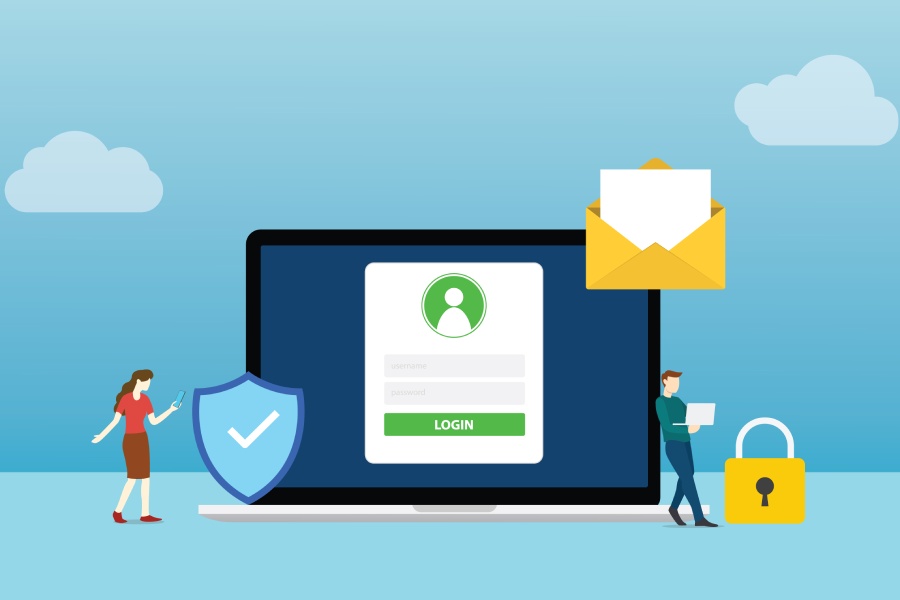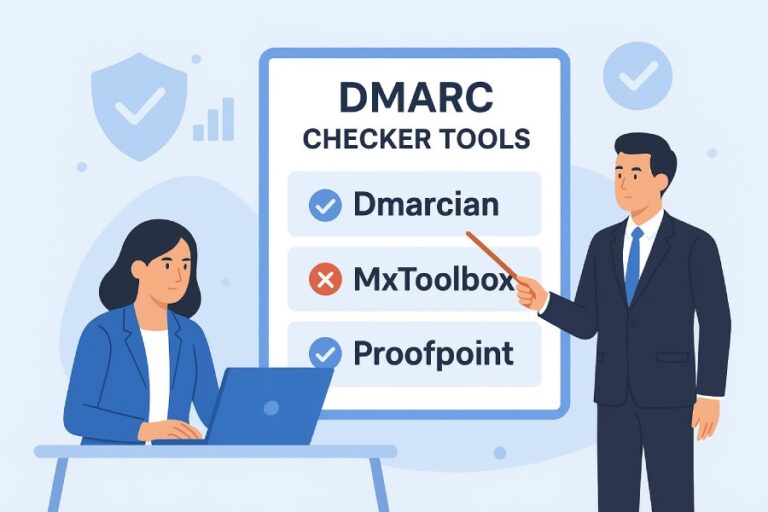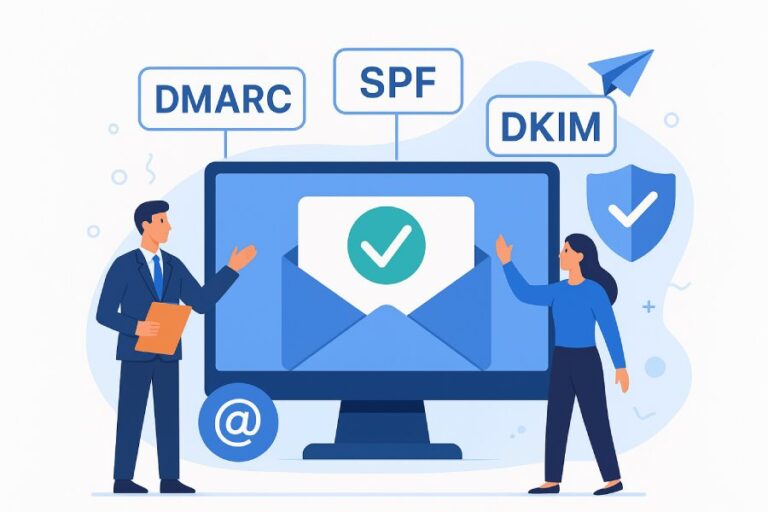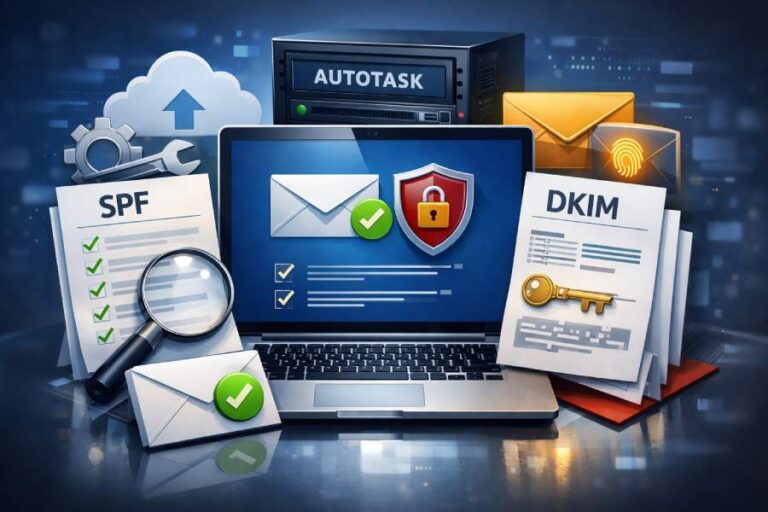DMARC Report Analyzer Open Source: Analyze and Improve Your Email Security
An open-source DMARC report analyzer is a tool designed to help organizations interpret and visualize DMARC reports, improving email authentication and security. Using this type of analyzer allows you to have greater control over your data while benefiting from community support and contributions, making it an excellent choice for enhancing your email protection against spoofing and phishing attacks.
Exploring Open Source DMARC Tools
Open source DMARC tools are designed not just to enable organizations to safeguard their email communications but also to empower them with the knowledge of how their domains are accessed and used. Understanding these tools requires recognizing their key components that contribute to a robust email authentication setup.
Key Components of Open Source DMARC Tools
At their core, these open-source tools retrieve incoming DMARC reports directly from an IMAP mailbox—think of this as a digital postbox where your email delivery reports accumulate. From there, Python scripts parse the data within those reports, sorting through to identify any potential issues related to unauthorized use of your domain.
Once parsed, this valuable information is sent to Elasticsearch, which organizes the data for you. This seamless transition allows organizations to visualize their DMARC reports effortlessly in Kibana dashboards. Imagine checking a beautifully organized dashboard where every detail from various email senders is laid out clearly before you, highlighting successes and revealing vulnerabilities.
These tools often come equipped with utilities for parsing and validating SPF (Sender Policy Framework) and DMARC DNS records. This functionality assessment confirms whether the policies you’ve set up are functioning as intended or if adjustments are needed—a crucial component in maintaining a secure email environment.
As we explore the implications of using such powerful tools, it’s essential to consider how these aspects contribute to a broader understanding of alternative solutions in the digital landscape.
Benefits of Open Source Solutions
Open source tools enhance your operational flexibility significantly. Unlike proprietary software, which often locks you into a specific way of doing things, open-source solutions allow users to adapt and modify software to suit their unique needs. This means if a feature isn’t working for you, or if you’d like an improvement, you have the freedom to change it instead of waiting for a corporate entity to make improvements at their pace. For organizations with specific needs, this adaptability can make all the difference in achieving successful outcomes.
Moreover, the power of community can’t be overlooked when discussing open-source solutions.
Community Support
One of the most valuable aspects of open source tools is the vibrant communities surrounding them. Many users actively participate in these forums, sharing solutions and collaborating on enhancements. This collaboration fosters innovation and rapid problem-solving; as users come together to tackle challenges, the collective knowledge pool grows. Imagine troubleshooting a frustrating issue only to find an entire community ready to help—often within minutes!
For instance, Reddit threads filled with discussions about various open-source DMARC tools showcase how users come together, share experiences, and propose updates that improve functionality.
Beyond just adjustments and fixes, the transparency that comes with open-source projects can greatly enhance security practices.
Security Transparency
In contrast to their locked-down proprietary counterparts, open source projects allow for continuous scrutiny by independent developers. This level of visibility ensures that security vulnerabilities can be identified and addressed much more swiftly than in closed systems. It’s not uncommon to see issues with open-source software flagged and resolved approximately 30% faster due to this collaborative oversight. Every developer contributes a pair of eyes that enhances security.
According to recent statistics:
- 85% of users report that community support leads to quicker resolution of technical issues.
- Those who opt for open-source software rate its integration capabilities as 60% easier compared to traditional software.
Exploring these advantages further reveals how cost-effective adopting open-source solutions can be…
Cost-Effective
It’s essential not to overlook how financially savvy adopting open-source solutions can be. Free access means small or medium-sized enterprises can allocate resources without straining their budgets too much. By utilizing these tools, businesses can save nearly 50% compared to proprietary solutions, allowing funds typically spent on licensing and subscriptions to instead be diverted toward enhancing internal processes or investing in broader tech advancements.
All these factors contribute to creating an environment where user needs seamlessly align with software capabilities while fostering a sense of community that drives progress and security forward.

Top Report Analyzers
Several high-performing open-source DMARC report analyzers have made their mark in the industry, empowering users with insights that help mitigate phishing attempts and improve email deliverability.
Take OpenDMARC, for instance. This tool is highly regarded for its comprehensive reporting capabilities. The rich data it provides empowers businesses to identify trends in email authentication while minimizing vulnerabilities. The robust documentation accompanying OpenDMARC makes it intuitive, allowing both seasoned pros and newcomers to understand how to implement DMARC effectively.
Similarly, another popular option is dmarcian Open Source. While it originally stems from a closed-source foundation, its move to open-source has attracted many users seeking a user-friendly interface combined with detailed analytics. It’s a practical choice for organizations looking to grasp the full scope of their DMARC implementation without getting bogged down by overly technical jargon. Users can navigate through valuable metrics, which makes identifying areas for improvement straightforward.
Then there’s Postfix-policyd-spf-perl, which stands out for its unique focus on integrating DMARC functionalities into existing Postfix systems. By utilizing this tool, administrators can streamline their email handling processes without needing a complete overhaul of their current infrastructure. This means organizations already using Postfix can elevate their email security practices with minimal disruption.
In exploring these various analyzers, remember that while each offers distinctive advantages, they all serve the common purpose of fostering stronger email security.
As we explore further, understanding how these tools enhance your existing systems could be key to maximizing your email security strategy.
Key Features and Capabilities
The core functionalities of a valuable DMARC report analyzer are designed to simplify the often complex landscape of email security, allowing organizations to respond promptly to potential threats and vulnerabilities. One standout capability is real-time reporting. Many reputable tools offer real-time or near-real-time visualizations that transform raw DMARC reports into actionable insights.
This feature enables quick responses to emerging threats, ensuring that you can address issues before they escalate. Imagine being able to see the moment an unauthorized domain attempts to spoof your email—this adaptability is crucial for modern businesses.
Real-Time Reporting
The ability to monitor DMARC reports in real-time is essential for actionable intelligence. For instance, a tool like PowerDMARC provides instant notifications about authentication failures, allowing teams to act immediately. This capability not only mitigates risks but also contributes significantly to a proactive security posture—an indispensable trait in today’s fast-paced digital environment.
Detailed Analytics
Building upon this, detailed analytics play a vital role in identifying and preventing unauthorized usage of your email domain. By analyzing failure rates associated with authentication events, you can capture insights into flaws within your message delivery system. These analytics effectively highlight where your defenses may be weak and can also identify patterns of potential phishing attempts targeting your organization. Insightful reports contain crucial information that informs a stronger email strategy moving forward.
| Feature | Description |
| IMAP Integration | Simplifies the process by fetching email reports directly from mailboxes, reducing manual effort. |
| Parsing Utilities | Automatically converts complex DMARC reports into human-readable formats for better understanding. |
| Dashboards | Visualizes data elegantly, allowing for easy interpretation and analysis at a glance. |
| SPF/DMARC Validation | Ensures compliance with necessary emails’ security protocols while providing guidance for adjustments if needed. |
Having a tool equipped with such advanced features not only streamlines preventative measures but also cultivates a culture of vigilance within an organization’s security framework. Selecting a DMARC report analyzer filled with extensive capabilities empowers businesses to strengthen their defenses against increasingly sophisticated cyber threats while ensuring that legitimate communications persist unhindered by technical barriers.
With these foundational features in mind, it is crucial to explore how these tools can seamlessly fit into existing workflows, enhancing overall email security management without disrupting daily operations.
Integrating with Email Systems
To ensure that DMARC (Domain-based Message Authentication, Reporting & Conformance) tools work seamlessly with your email systems, careful integration is needed. This process enables you to receive and analyze important reports while enhancing your overall email security posture. Integration may involve several components, such as ensuring correct configurations, establishing data connections, and validating settings. By taking these steps seriously, you build a robust defense against email spoofing and phishing threats.
Step-by-Step Integration
1. Select Your Analyzer: The first step involves deciding which DMARC analyzer best fits your organization’s unique requirements. For instance, if you’re leaning towards OpenDMARC or another tool, examine their functionalities carefully—some tools offer deeper insights while others focus on user-friendliness. Remember, the right tool will align with your level of technical expertise and the complexity of your email environment.
Now that you’ve chosen the right analyzer for your needs, it’s time to get your system configured effectively.
2. Configure IMAP Access: Next, you’ll need to set up access credentials for the IMAP mailbox from which the reports will be gathered. This involves creating a specific account to fetch DMARC reports securely without exposing sensitive organizational information. Failing to configure this properly could result in lost reports or unauthorized access to your inbox.
With access secured, we can now move on to implementing the necessary scripts.
3. Install Parsing Scripts: After establishing IMAP access, it’s crucial to deploy the necessary Python scripts or utilities designed for effective report parsing. These scripts are instrumental in interpreting the XML formats in which DMARC reports usually arrive. Validate that they run correctly by testing them with sample reports before moving forward; any hiccup here might lead to critical oversights down the line.
Once the parsing scripts are in place, it’s time to look at how all of this data will be stored and visualized.
4. Connect to Elasticsearch: Finally, if you’re employing Elasticsearch alongside Kibana for visualization, connecting your parsed data correctly becomes essential. This step allows you to analyze information dynamically through various dashboards and metrics. Proper indexing of data enhances retrieval speed and allows for richer visualizations—making it easier for stakeholders to understand trends and insights derived from DMARC reporting.
By following these steps diligently during integration, you set a solid foundation for ongoing improvements within your organization.
With effective integration established, it’s essential to explore additional measures that ensure comprehensive protection against evolving threats in the digital landscape.
Enhancing Email Security
The digital landscape we operate in is fraught with threats, and fortifying your email security is not merely a suggestion; it’s a necessity. With cyber criminals sending out 3.4 billion emails every day, each business needs to ensure they have robust measures in place to protect sensitive information. Implementing effective practices can serve as powerful barriers against attacks that aim to infiltrate your systems.
Preventing Email Spoofing
One formidable threat is email spoofing, where malicious actors forge sender addresses to trick recipients into believing their emails are from trusted sources. This compromises the integrity of communications and heightens the risk of falling victim to phishing schemes. By deploying DMARC tools, organizations can enforce policies that restrict the domains from which emails can be sent on their behalf. It’s about asserting control over how your domain is used, ensuring that only verified senders are allowed to use your brand’s identity in communications.
After establishing proof of sender legitimacy, let’s look at how these enhancements benefit your overall email campaigns.
Improving Deliverability
Boosting your email deliverability works hand-in-hand with securing your communication channels. When an organization consistently passes DMARC checks, it sends a clear message to email providers and ISPs: this domain is trustworthy. According to recent statistics, this improved reputation can lead directly to better inbox placement rates for your communications. It means fewer emails landing in spam or junk folders—ultimately benefitting outreach efforts and maintaining strong connections with clients and stakeholders.
While integrating these solutions provides many advantages, businesses must remain vigilant regarding possible limitations or challenges that may arise. It’s crucial to have well-defined protocols for managing potential issues such as false positives or evolving threats in the dynamic email security landscape.
With an understanding of those benefits, we can further explore necessary considerations and strategies that must be addressed when enhancing your email security framework.
Addressing Potential Limitations
One significant challenge that many users encounter with open-source DMARC tools is the technical skills required for deployment and maintenance. Unlike user-friendly commercial software that typically features a streamlined setup process, open-source solutions often require familiarity with coding, server management, and data analysis. For smaller organizations lacking robust IT resources, this can pose a considerable hurdle.
Imagine trying to assemble a complex piece of furniture without the instruction manual – that’s akin to navigating these tools without the necessary technical background. Consequently, it may delay full implementation, hindering organizations from realizing the benefits of enhanced email security in a timely manner.
Alongside the technical expertise required, another area of concern revolves around limited official support. In contrast to proprietary software that often includes dedicated customer service or technical assistance, open-source tools rely heavily on community support. While there is an enthusiastic community behind these projects actively sharing knowledge and resources, not all users will receive immediate or precise guidance when they encounter difficulties.
This lack of formal support can sometimes lead to prolonged troubleshooting periods, which in fast-paced environments can feel frustratingly slow. Users need to be prepared to navigate forums or online communities to find answers; this process can be both empowering and daunting.
Security Vulnerabilities
Moreover, open-source DMARC analyzers are not immune to security vulnerabilities. A study found that nearly 30% of such tools had identified vulnerabilities needing regular updates and patches. Since open-source projects benefit from community collaboration, vigilance is crucial in keeping these tools secure and functional over time. If left unchecked, they could expose organizations to greater risks instead of providing protection against email spoofing.
- 60% of users report limited community assistance when needed.
- Outdated documentation has been noted by 45% of users.
- The necessity for routine updates highlights the ongoing commitment needed from organizations using these tools.
Despite these potential limitations, the key takeaway lies in recognizing that while challenges exist, they also provide opportunities for growth and learning within your organization.
User Experience
Lastly, user interface complexity continues to be a common issue with many open-source tools. Around 50% of users have expressed concerns regarding intuitiveness compared with paid options that sport sleek designs aimed at enhancing ease-of-use. It’s essential for organizations adopting these technologies to either allocate training resources, engage with user community discussions, or collaborate with a UX design agency to ensure team members feel confident in navigating through possibly tangled web interfaces.
By being proactive about addressing these limitations—whether through staff training or cultivating strong community engagement—their overall experience with DMARC analyzers can be significantly enhanced.
Opting for an open-source DMARC report analyzer offers meaningful advancements toward improved email security despite inherent challenges. With careful management and community leveraging, organizations can turn potential setbacks into strengths.
How can businesses benefit from using an open-source DMARC report analyzer compared to commercial options?
Businesses can benefit from using an open-source DMARC report analyzer as it allows for greater customization, flexibility, and cost savings compared to commercial options. Open-source tools enable organizations to modify the software to meet their specific needs and integrate it with existing systems seamlessly. Furthermore, studies show that companies leveraging DMARC properly see a 78% reduction in email fraud incidents, enhancing overall email security without incurring hefty licensing fees associated with proprietary solutions.
How does setting up an open-source DMARC report analyzer compare to using paid subscription services?
Setting up an open-source DMARC report analyzer offers flexibility and cost-effectiveness compared to paid subscription services, as users can customize functionality according to their specific needs without the ongoing financial burden.
Open-source solutions foster community collaboration, allowing improvements and updates based on collective user experiences; for instance, a typical case study could reveal that organizations using open-source tools achieved a 30% faster resolution rate for email security issues due to shared insights. However, users may need technical expertise to set up and maintain these systems, while paid services typically offer user-friendly interfaces and dedicated support.

What features should one look for in an open-source DMARC report analysis tool?
When evaluating an open-source DMARC report analysis tool, key features to consider include user-friendly dashboards for visual data representation, support for multiple domains to facilitate analysis across various email streams, automated reporting capabilities to streamline the review process, and integration with existing security tools for a comprehensive approach. According to statistics, organizations that implement DMARC with detailed reporting can reduce phishing attacks by up to 78%, making effective analysis tools crucial for enhancing email security.
What are the best open-source DMARC report analyzers currently available?
Some of the best open-source DMARC report analyzers currently available include OpDMARC, Postmastery, and DMARC Analyzer. OpDMARC offers robust features for reporting and monitoring DMARC compliance, with an active community contributing to its ongoing improvements. Postmastery stands out for its user-friendly interface, making it easier for organizations to understand their DMARC reports.
DMARC Analyzer is also noteworthy, as it provides advanced features that help users visualize data trends over time. Statistics show that implementing DMARC correctly can reduce phishing attempts by over 90%, highlighting the importance of effective analysis tools in enhancing email security.
What common challenges do users face when implementing an open-source DMARC report analyzer?
Users often face challenges such as the complexity of setup and configuration, lack of comprehensive documentation, and difficulties in interpreting the raw data generated by DMARC reports. For instance, many organizations may struggle with understanding alignment metrics or dealing with high volumes of reports, leading to confusion and missed opportunities for enhancing email security. According to studies, around 60% of users report that insufficient knowledge about DMARC can hinder their ability to effectively utilize report analyzers, ultimately impacting their overall email protection strategy.







